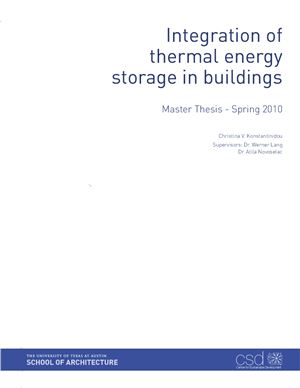На английском языке. Магистерская диссертация. Работа выполнена в
The University of Texas at Austin, 2010, 108pp.
Abstract
The diual changes in temperature and solar radiation pose challenges for maintaining thermal comfort for people in buildings. Passive and energy-conserving buildings seek to manage the available thermal energy in order to maintain conditions for human comfort. This project investigates how heat storage strategies can be integrated in the building components as a strategy to reduce building energy consumption in hot climates. Specifically, it focuses on phase change materials that are integrated in the building structures and are used to substitute the thermal mass of a building in cases of lightweight construction.
A research protocol is performed on conventional structural materials that are used as integrated energy storage, their implementation and their effect on the noctual recharge of the envelope’s thermal mass. Phase change materials that make use of the latent heat of a substance, storing and releasing the energy of the phase change of a substance are examined in detail. Several applications of phase change materials for temperature control of buildings are also investigated. During the second phase of this study, simulation research is performed to evaluate some of the investigated systems. Several solutions using new technologies and phase change materials are integrated on an experimental building and simulated using Energy Plus. Comparisons are made for the various simulated systems in terms of their performance and energy consumption. Last, but not least, an investigation of the economical feasibility of the examined systems is performed.
Phase change materials that have a melting point near room temperature can replace thermal mass without the bulk of large masonry structures. This can lead to a signifi cant reduction of the building energy consumption, as well as reduction of conventional structure materials. These energy-storing building materials can reduce peaks in demand by creating a more even load-time characteristic. Furthermore, appropriate thermal storage can be used to achieve a significant reduction in equipment cycling frequency and thus achieve a noticeable increase in operating effi ciency. The high initial cost of phase change materials can therefore be reclaimed by the savings in conventional materials, primary energy and peak load reduction, as well as increase in operation efficiency. The building thermal mass, combined with smart materials and intelligent techniques of mass recharge can signifi cantly affect the building energy consumption. These strategies can have a signifi cant effect on hot-dry climates, as well as hot-humid climates when combined in the optimum way. This study aims at the development of a typology of integrated systems of thermal storage in the building envelope using smart materials in combination with mass recharge systems. An assessment of several phase change material applications is also achieved.
Abstract
The diual changes in temperature and solar radiation pose challenges for maintaining thermal comfort for people in buildings. Passive and energy-conserving buildings seek to manage the available thermal energy in order to maintain conditions for human comfort. This project investigates how heat storage strategies can be integrated in the building components as a strategy to reduce building energy consumption in hot climates. Specifically, it focuses on phase change materials that are integrated in the building structures and are used to substitute the thermal mass of a building in cases of lightweight construction.
A research protocol is performed on conventional structural materials that are used as integrated energy storage, their implementation and their effect on the noctual recharge of the envelope’s thermal mass. Phase change materials that make use of the latent heat of a substance, storing and releasing the energy of the phase change of a substance are examined in detail. Several applications of phase change materials for temperature control of buildings are also investigated. During the second phase of this study, simulation research is performed to evaluate some of the investigated systems. Several solutions using new technologies and phase change materials are integrated on an experimental building and simulated using Energy Plus. Comparisons are made for the various simulated systems in terms of their performance and energy consumption. Last, but not least, an investigation of the economical feasibility of the examined systems is performed.
Phase change materials that have a melting point near room temperature can replace thermal mass without the bulk of large masonry structures. This can lead to a signifi cant reduction of the building energy consumption, as well as reduction of conventional structure materials. These energy-storing building materials can reduce peaks in demand by creating a more even load-time characteristic. Furthermore, appropriate thermal storage can be used to achieve a significant reduction in equipment cycling frequency and thus achieve a noticeable increase in operating effi ciency. The high initial cost of phase change materials can therefore be reclaimed by the savings in conventional materials, primary energy and peak load reduction, as well as increase in operation efficiency. The building thermal mass, combined with smart materials and intelligent techniques of mass recharge can signifi cantly affect the building energy consumption. These strategies can have a signifi cant effect on hot-dry climates, as well as hot-humid climates when combined in the optimum way. This study aims at the development of a typology of integrated systems of thermal storage in the building envelope using smart materials in combination with mass recharge systems. An assessment of several phase change material applications is also achieved.

